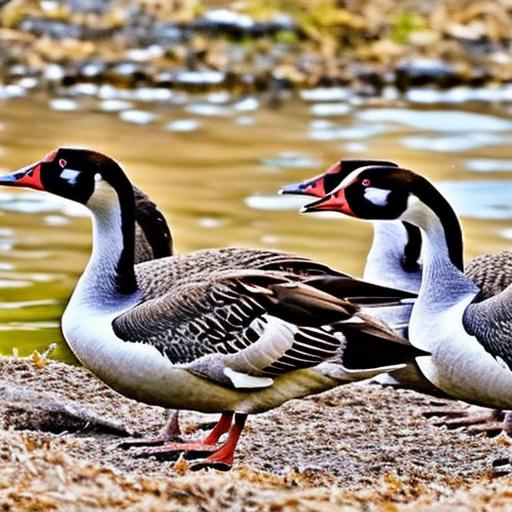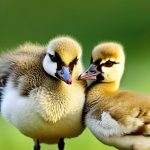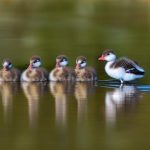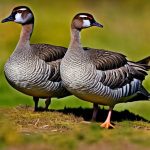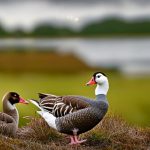The Canadian geese breeding season is a crucial time for these majestic birds. It is during this time that they engage in courtship rituals, build nests, lay eggs, and raise their young. Understanding the breeding season is important for researchers, conservationists, and wildlife enthusiasts alike, as it allows us to gain insights into the behavior and biology of these birds.
Key Takeaways
- Canadian geese breeding season occurs in the spring and summer months
- During breeding season, geese undergo physical and behavioral changes
- Mating rituals involve pair bonding and vocalizations
- Geese prefer to nest near water and use a variety of materials to build their nests
- Incubation period lasts around a month and both parents share in parental care responsibilities
Physical and behavioral changes during breeding season
During the breeding season, Canadian geese undergo several physical and behavioral changes. One noticeable change is in their physical appearance. Male geese, known as ganders, develop a larger size and more vibrant plumage. They also develop a distinctive knob on their beak, which is absent in females. This change in appearance helps attract potential mates.
In terms of behavior, Canadian geese become more territorial during the breeding season. They establish nesting territories and defend them vigorously against intruders. They also become more vocal, honking loudly to communicate with their mate and ward off potential threats. Additionally, they engage in elaborate courtship displays, such as head bobbing and wing flapping, to attract a mate.
Mating rituals and pair bonding
Mating rituals play a crucial role in the breeding season of Canadian geese. These rituals involve a series of behaviors that help establish pair bonds between males and females. One common ritual is the “neck stretch,” where the male extends his neck upward while honking loudly. This behavior is often reciprocated by the female as a sign of acceptance.
Pair bonding is essential for successful reproduction in Canadian geese. Once a pair bond is formed, it typically lasts for life. This bond ensures that both parents are committed to raising their offspring together. It also provides stability and support during the nesting and incubation period.
Nesting habits and preferences
Canadian geese have specific nesting preferences when it comes to choosing a suitable site. They prefer nesting near bodies of water, such as lakes, ponds, or rivers. These sites provide easy access to food and water for both the parents and their young. The geese also prefer nesting in areas with tall grasses or shrubs, which provide cover and protection from predators.
When it comes to building their nests, Canadian geese use a combination of materials such as twigs, grass, and feathers. The female takes the lead in constructing the nest, while the male stands guard nearby. The nests are typically large and bulky, providing a secure and comfortable environment for the eggs.
Incubation period and hatching of eggs
The incubation period for Canadian geese eggs is approximately 25-30 days. During this time, the female remains on the nest, incubating the eggs while the male stands guard nearby. The female rarely leaves the nest, relying on the male to bring her food.
Once the eggs are ready to hatch, the goslings use their egg tooth to break through the shell. This process can take several hours or even days. Once hatched, the goslings are covered in down feathers and are capable of walking and swimming shortly after birth.
Parental care and responsibilities
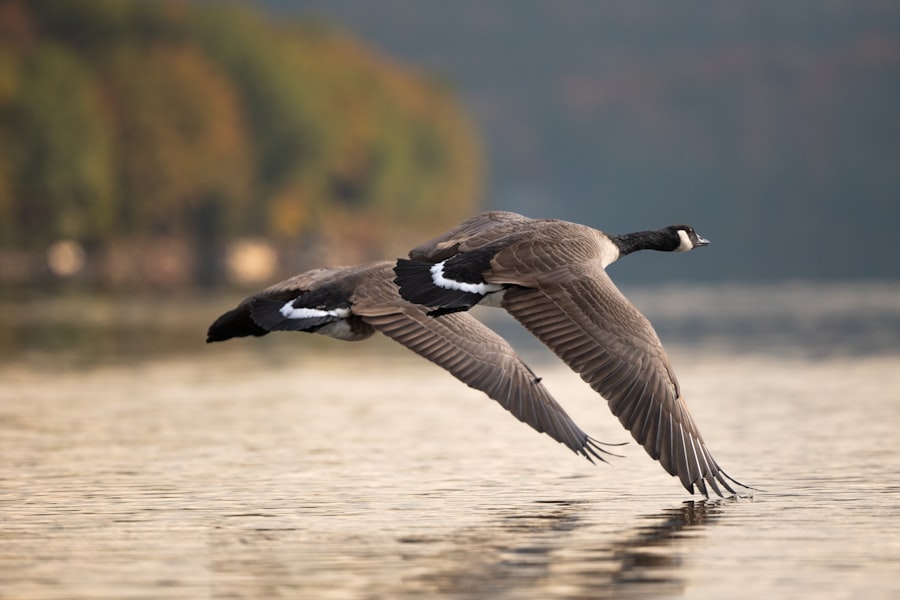
Both parents play an active role in caring for their young. The female provides warmth and protection by brooding the goslings under her wings. She also guides them to food sources and teaches them essential survival skills.
The male’s responsibilities include defending the nest and territory from predators and intruders. He also assists in finding food for the female and goslings. Both parents work together to ensure the safety and well-being of their offspring.
Challenges faced during breeding season
The breeding season poses several challenges for Canadian geese. Natural challenges include predation from animals such as foxes, raccoons, and coyotes. Nesting sites near water bodies can also be prone to flooding, which can destroy nests and eggs.
Human-induced challenges are also a significant threat to Canadian geese during the breeding season. Habitat loss due to urbanization and agriculture can reduce suitable nesting sites. Pollution of water bodies can also affect the quality of food and water available to the geese.
Importance of habitat and environmental factors
Habitat plays a crucial role in the breeding success of Canadian geese. Suitable nesting sites near water bodies provide the necessary resources for the geese to thrive. These habitats also offer protection from predators and provide ample food sources.
Environmental factors such as water quality and availability also impact breeding success. Pollution of water bodies can lead to a decline in food sources, affecting the health and reproductive success of the geese. Climate change can also disrupt the timing of breeding seasons, leading to mismatches between food availability and hatching times.
Population management and conservation efforts
Population management strategies are implemented to ensure the sustainable management of Canadian geese populations. These strategies include monitoring population numbers, implementing hunting regulations, and managing nesting sites to prevent overpopulation.
Conservation efforts are also crucial for protecting Canadian geese and their breeding habitats. These efforts involve habitat restoration, creating protected areas, and educating the public about the importance of these birds in the ecosystem.
The significance of Canadian geese breeding season for ecosystem balance
The Canadian geese breeding season is not only important for the survival of these birds but also for maintaining ecosystem balance. As herbivores, Canadian geese play a vital role in controlling vegetation growth in their habitats. Their feeding habits help maintain healthy wetland ecosystems by preventing overgrowth of plants.
Understanding the breeding season allows us to appreciate the complexity of these birds’ lives and their importance in maintaining biodiversity. By protecting their habitats and implementing conservation measures, we can ensure that future generations will continue to witness the beauty and significance of Canadian geese in our ecosystems.
If you’re interested in learning more about the breeding season of Canadian geese, you might also find this article on how to care for goslings from Poultry Wizard informative. It provides valuable insights and tips on raising healthy and happy goslings during this crucial period. Check it out here. Additionally, if you’re considering building a chicken coop to house your feathered friends, Poultry Wizard’s article on the A-frame chicken coop design is worth a read. Discover the benefits and features of this practical coop style here. And if you’re looking for a convenient way to transport your chicken coop, their article on the chicken coop portage system might be just what you need. Find out more about it here.
FAQs
What is the breeding season for Canadian geese?
The breeding season for Canadian geese typically occurs between March and June.
Where do Canadian geese breed?
Canadian geese breed in a variety of habitats, including wetlands, lakes, and rivers throughout Canada and the United States.
How many eggs do Canadian geese lay?
Canadian geese typically lay between 4 and 8 eggs per clutch.
How long does it take for Canadian goose eggs to hatch?
Canadian goose eggs typically take around 25-28 days to hatch.
Do Canadian geese mate for life?
Yes, Canadian geese are known to mate for life and often return to the same breeding grounds year after year.
How do Canadian geese protect their nests?
Canadian geese are known to be very protective of their nests and will aggressively defend them from predators. They may also use distraction displays to lure predators away from the nest.
What is the lifespan of a Canadian goose?
Canadian geese can live up to 25 years in the wild.
Are Canadian geese considered a nuisance?
While Canadian geese are a beloved symbol of wildlife, they can also be considered a nuisance due to their large populations and tendency to leave droppings in public areas.
Meet Walter, the feathered-friend fanatic of Florida! Nestled in the sunshine state, Walter struts through life with his feathered companions, clucking his way to happiness. With a coop that’s fancier than a five-star hotel, he’s the Don Juan of the chicken world. When he’s not teaching his hens to do the cha-cha, you’ll find him in a heated debate with his prized rooster, Sir Clucks-a-Lot. Walter’s poultry passion is no yolk; he’s the sunny-side-up guy you never knew you needed in your flock of friends!

